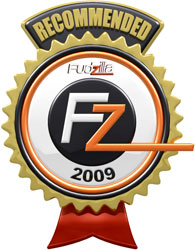Back in 2007, ATI launched its first 55nm GPUs, and the introduction of the RV670 marked a turning point for AMD's graphics division. Its first 55nm GPUs weren't faster than Nividia's G92 65nm based cards, but value oriented consumers quickly realized HD 3800 series card offered good value for money, and ATI upped the ante last year with its RV7x0 generation, and for a while it even managed to snatch the performance crown from Nvidia with its dual-GPU R700. Now, it's time to go to 40nm, but this time ATI is aiming at the mainstream market, not the performance segment.
The new RV740 is the first 40nm desktop GPU, and although mobile GPUs derived from the RV740 were announced back at CeBIT, this is the first time we've got a chance to see the new architecture in action. ATI claims the RV740 is designed to hit the 'sweet spot' and offer the best bang for buck. It is targeting the sub-$100 market and offering performance on par with the HD 4850 and GTS 250. Sounds reasonable, so let's take a look at the specs and what it offers compared to current ATI products in a similar price range.
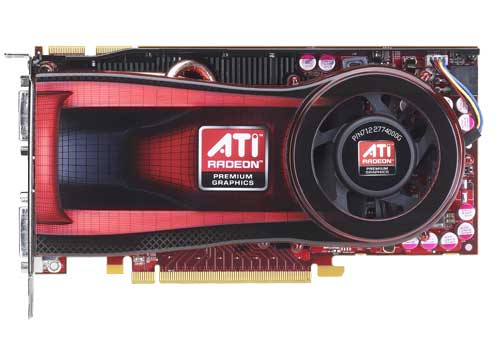
The HD 4670 has 512 million transistors, 320 stream processors and churns out 480 GFLOPS. Moving up the ladder, the RV770-based HD 4850 has 956 million transistors, 800 stream processors and boasts 1 TFLOPS of power. The new RV740 packs 826 million transistors on the 136mm2 40nm die, has 640 stream processor and ATI promises 960 GLOPS. It obviously comes close to the HD 4850 in most respects, and thanks to GDDR5, even its 128-bit memory bus isn't a bottleneck, as it offers 51.2GB/s versus HD 4850's 64GB/s.
AMD started using GDDR5 on HD 4870 cards, when the company compensated for the weaker 256-bit bus on its cards, whereas Nvidia extensively used the 512-bit bus combined with GDDR3. In HD 4770's case, GDDR5 memory with a 128-bit memory bus will provide the same bandwidth as GDDR3 with 256-bit one, provided they both run at same clocks.

The new manufacturing process, coupled with the use of more advanced memory, also means the HD 4770 isn't power hungry. It's maximum power consumption is rated at 80W. This means it still needs external power, but it's pretty close to what PCIe can deliver without it. In spite of that, ATI went for a dual-slot cooler in its reference design, and at 750MHz, the core can heat up over 70°C.

A good thing about this cooling is that it's quiet and that the hot air is pushed out of the case. The design is similar to that on the HD 4870 cards, where two copper heatpipes are used (HD 4890 has 3).
The 512MB worth of Qimmonda's IDGV51-05A1F1C-40X modules is cooled by the heatsink. Two CrossFire connectors are located in the standard spot.
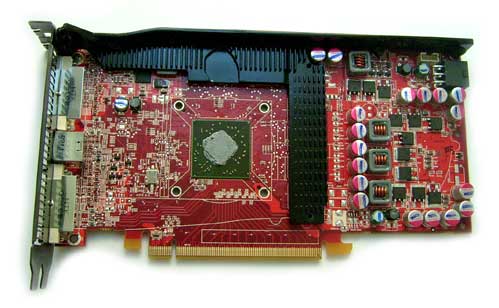
The I/O panel features two dual-link DVI connectors (with HDCP) supporting high resolution, and HDMI is possible via a dongle. ATI is also touting the advantages of DX10.1, including improved antialias on alpha channel materials, space ambient occlusion, improved shadow diffusion and gaussian filtered shadow maps.
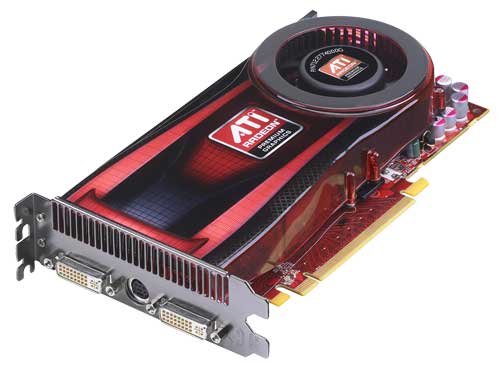
TestBed
Motherboard: MSI P45D3 Platinum ( Provided by: MSI );
Processor: Intel Core 2 QX9770 Extreme edition at 3.6GHz ( Provided by: Intel );
Memory: Corsair Dominator 12800 7-7-7-24 ( Provided by: Corsair);
HDD: WD VelociRaptor 300G 10,000RPM ( Provided by: SmoothCreation );
Driver: AMD 9-4_vista32_win7_32_dd_ccc_wdm_enu.exe
Nvidia_182.50_geforce_winvista_32bit_english_whql.exe
Vista 32 SP1
Futuremark Tests
In 3DMark 06 tests on the bottom of the table, where sub-$100 cards are located, Nvidia is a winner. Such results however are only found in this test whereas other tests see a fierce battle among the cards. Additionally, 3DMark06 results also show a low performance difference between HD 4850 and HD 4770 cards.
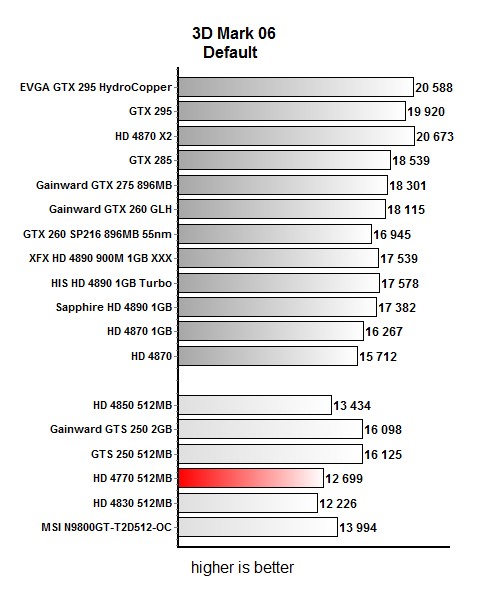
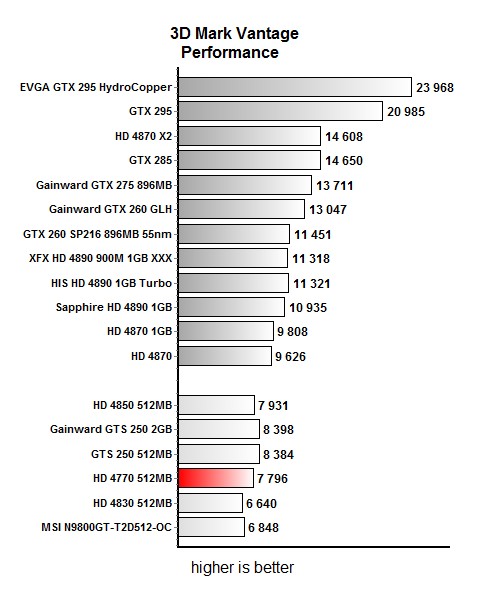
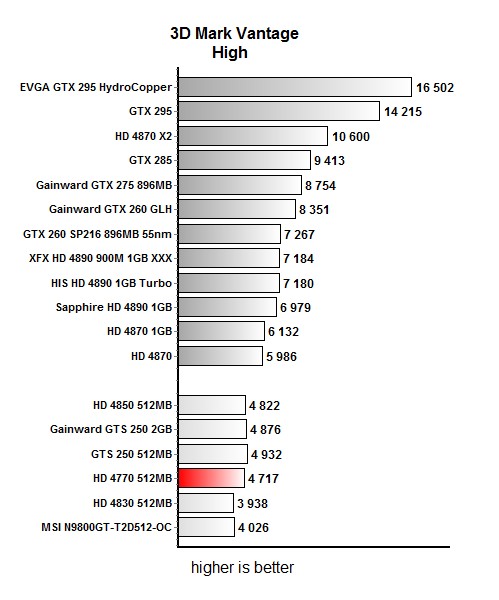
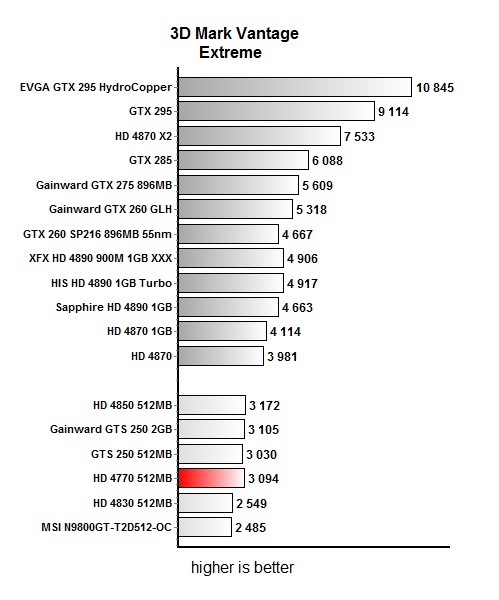
Gaming
World in Conflict
World in Conflict reports HD4850 to be up to 13% better than HD 4770. You can easily play games up to 1920x1200 resolution, provided there's no antialiasing.
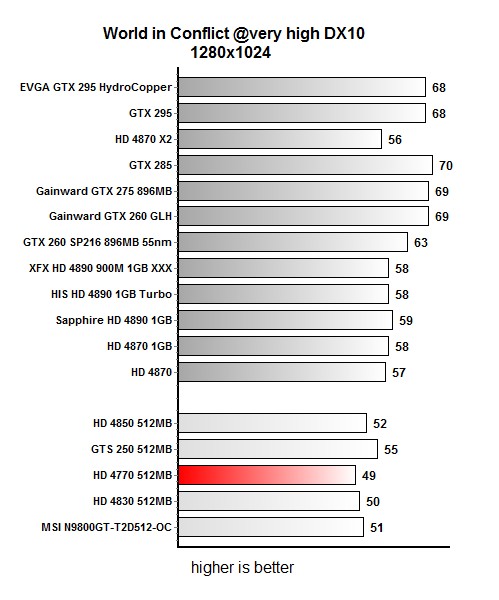
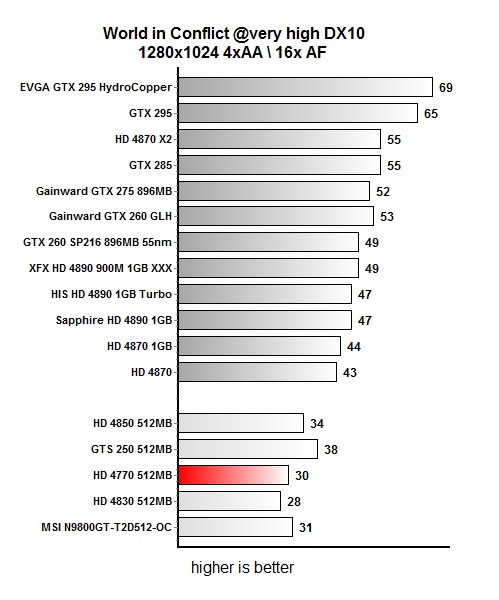
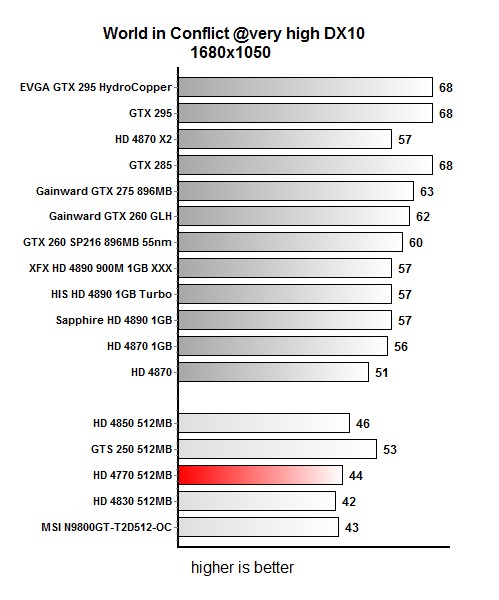

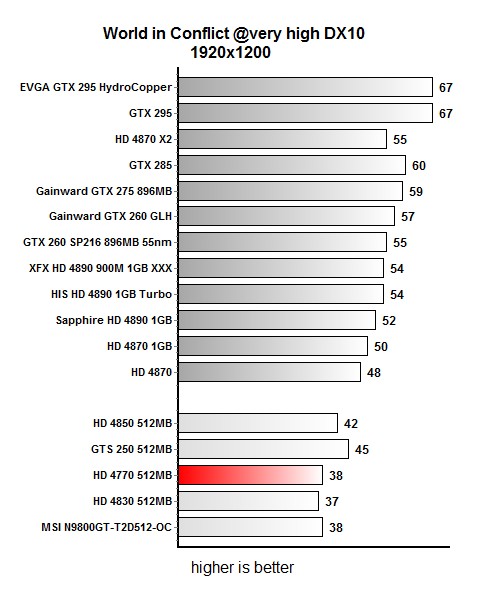
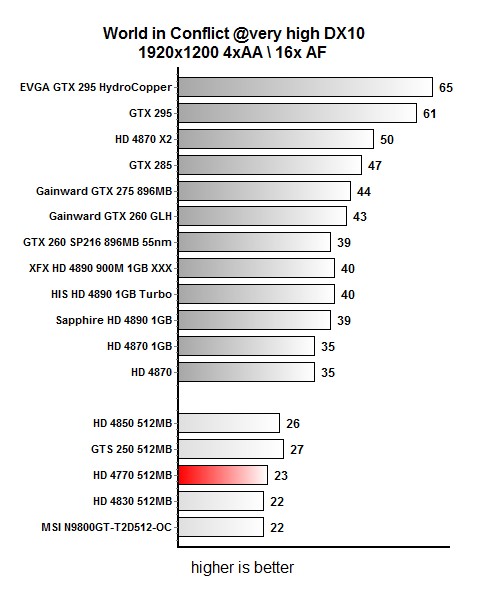
Left 4 Dead
Steam engine again got an update so there's no 9800GT results due to the fact that the demo we've been using and we have to get the new one (ERROR: demo network protocol outdated -> failed to read demo header). We're handling that at the moment, and we'll try to get the results as soon as possible.
Radeon HD 4850 shows up to 13% advantage over the HD 4770, but note that the advantage is higher if you're gaming with antialiasing on. The end result is a good framerate at all the tested resolutions with HD 4770.
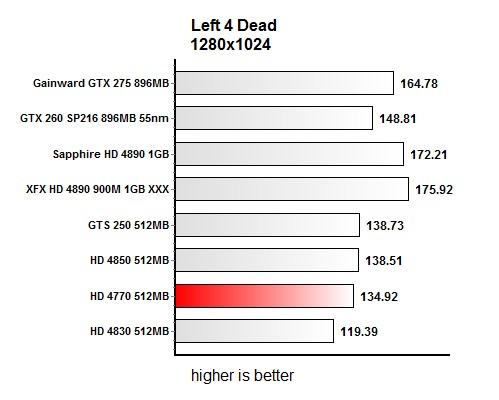
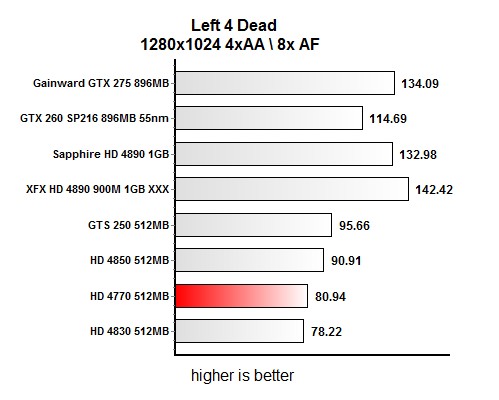
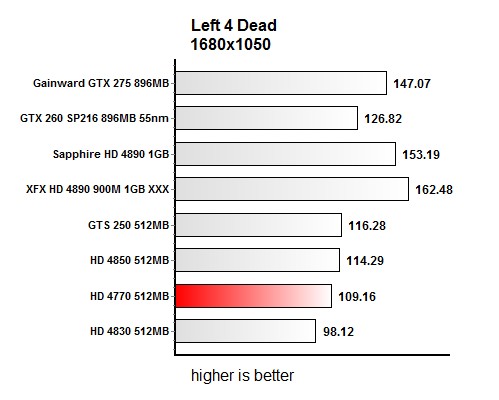
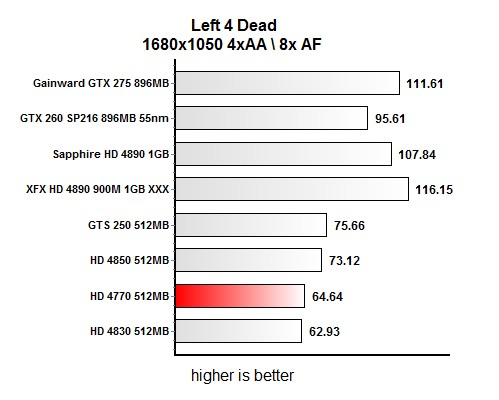
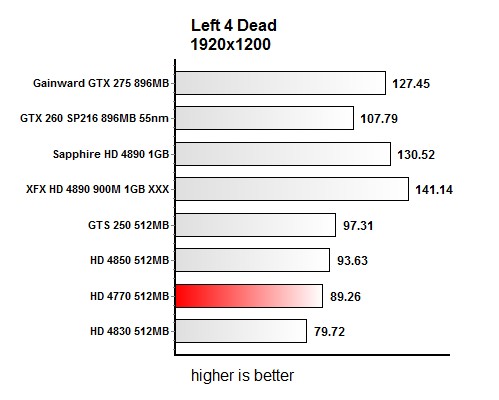
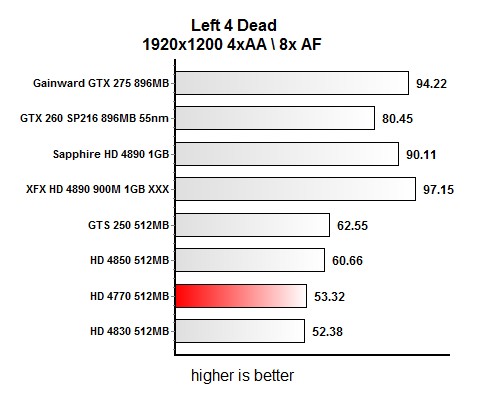
Far Cry 2
FarCry2 likes the HD 4770, which can easily be a result of optimized drivers. We've seen it has what it takes to stand up to HD 4850 and GTS 250 in this game, and that it allows for gaming at 1920x1200.
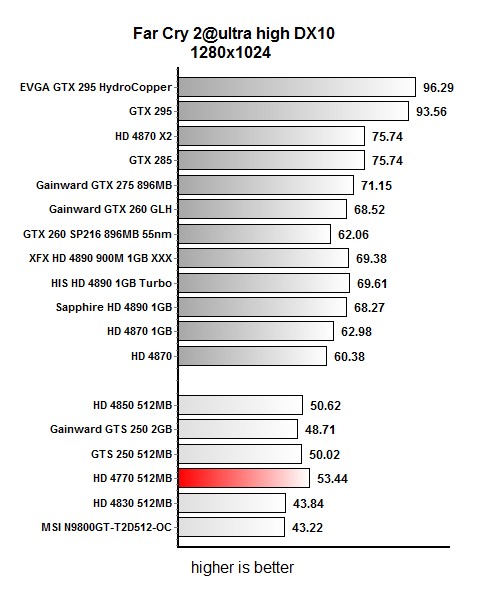
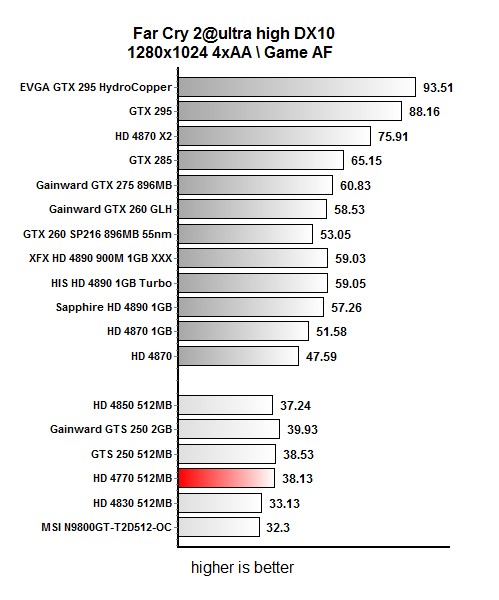
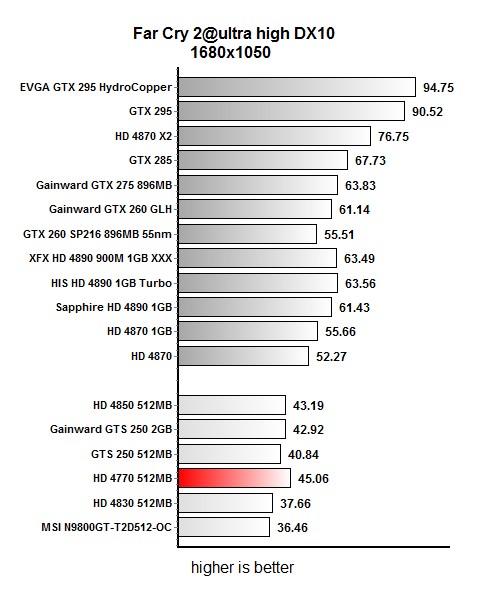
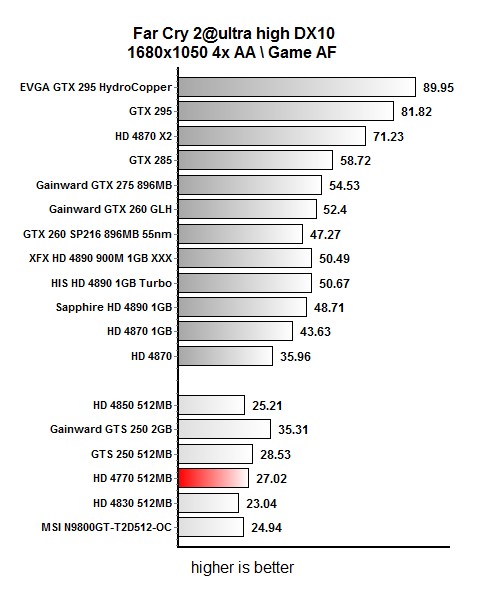
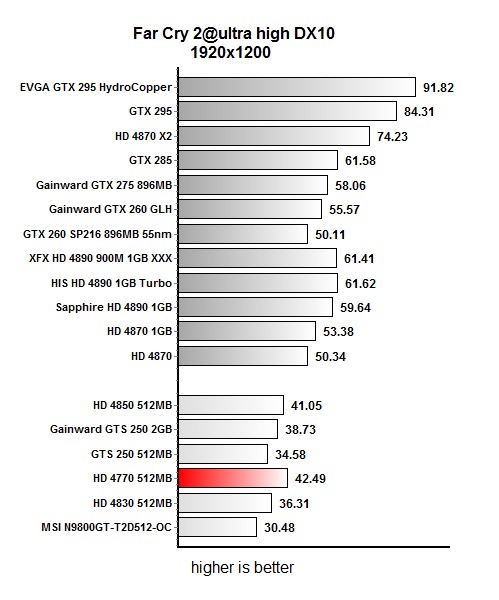
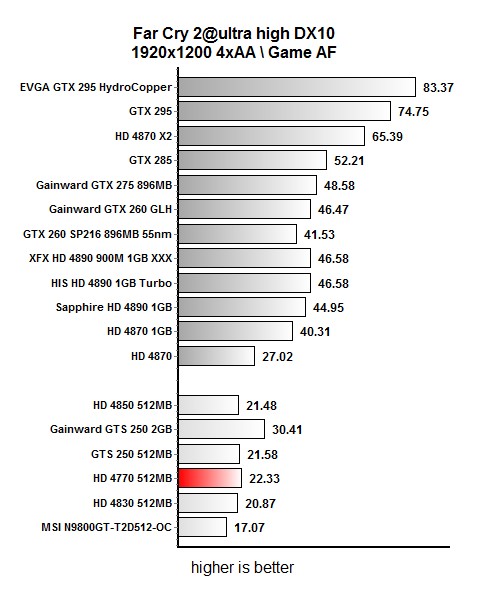
HAWX
Tom Clancy's H.A.W.X game is one of the big titles that feature support for DirectX 10.1. At 1920x1200 without AA and without DirectX 10.1 XFX HD 4890 scores 62FPS while with DirectX 10.1 enabled the same game scores 70 FPS. The same resolution but with AA and without DirectX 10.1 XFX scores 48 FPS while with DirectX 10.1 enabled it scores whopping 57 FPS. We are talking about 10 to 15 percent difference which is a lot.
With Nvidia cards, none of which have support for DirectX 10.1 there is no option to turn this feature on in the game. It took ATI long enough but at least with this title they made a huge difference with its ability to support DirectX 10.1.
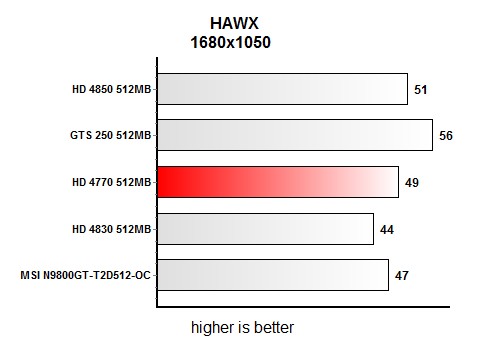
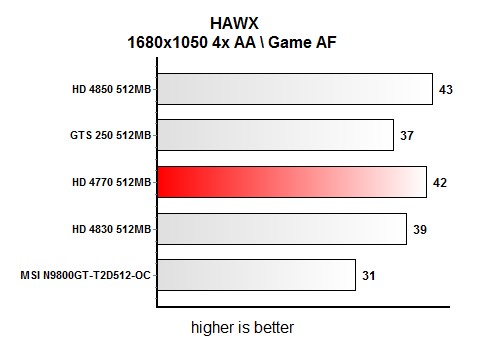
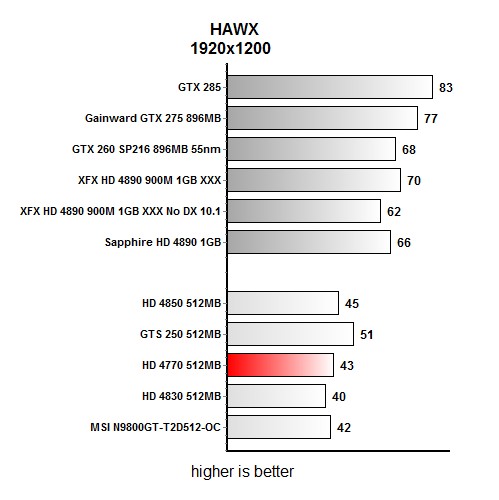
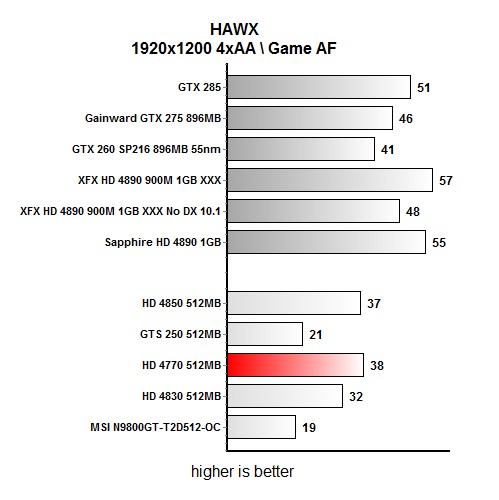
GPU Temperatures
HD 4770 thermals are good, as the card hits 74 degrees Celsius at max load. To put things into perspective, HD 4850 and HD 4830 can go over 90°C so these temperatures come as a result of the 40nm production process, and from using dual slot cooling, which is usually quiet except when fan rpm goes up to the max, which isn't quite ideal. Note that these maximum revs don't occur very often, but rest assured you'll know when they do.

Overclocking
Not much to say about overclocking – Catalyst driver allows for 830MHz GPU and 850MHz memory, and our card took it in stride. Using the overdrive engine, which calculates maximum overclock, we got an answer that the card will run at 820MHz GPU and 840MHz memory with no trouble whatsoever.
Overclocking brings up to 8% better results in FarCry 2.
Power Consumption
Radeon HD 4770 requires one 6-pin power connector, but as you can see for yourself, the consumption is quite low compared to the HD 4850. The only downside is the relatively high consumption in idle mode, and the reason for that is the memory which retains its 3D clocks in 2D mode as well.
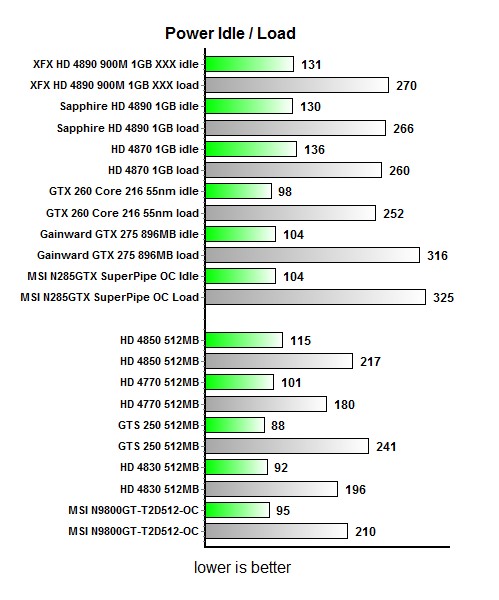
Conclusion
The HD 4770 is just a foretaste of things to come. You can imagine that high end cards stand to gain a lot from the new 40nm process, which has now transformed the sub-$100 market in the guise of the HD 4770.
The HD 4770 offers exceptional value for money, 826 million transistors in 40nm and DDR5 memory for just $99. It's powerful enough for most users and has enough muscle to run just about any game out there on sub-HD resolutions. It is overclockable, and we have no doubt AIBs will offer a number of interesting non-reference designs in the following weeks and months. As expected, it is a bit slower than the HD 4850, but a lot faster than the HD 4670, 4830 and similarly priced Nvidia cards. What's more, we're finally starting to see ATI endorsed DX10.1 offer some significant performance boosts in certain games.
Another scenario is also quite tempting. With its low price, power consumption of just 80W, and good thermals, the HD 4770 could even be an interesting basis for a Crossfire setup. The total price of such a setup would be under $200, and the power consumption just 160W. For comparison, a single HD 4870 is rated at 157W, while a single HD 4890 costs over $200.
We really can't think of any major drawbacks. ATI did a fine job, by the book, and ended up with a cheap, yet very fast card. At $99 or €89 it truly offers great value, especially considering it has the technological edge, and we're guessing it will make a lot of AMD accountants smile.
Without a doubt, ATI's firstborn 40nm card deserves our Recommended award, and it offers a glimpse into a brighter, 40nm future even for gamers on a budget.
